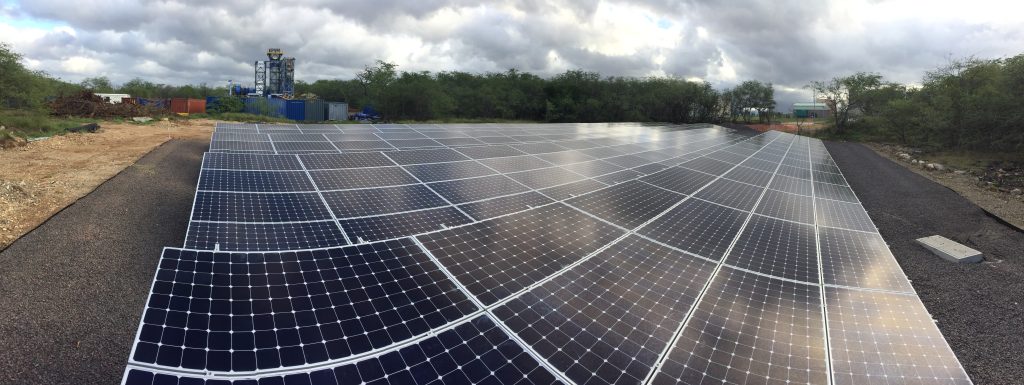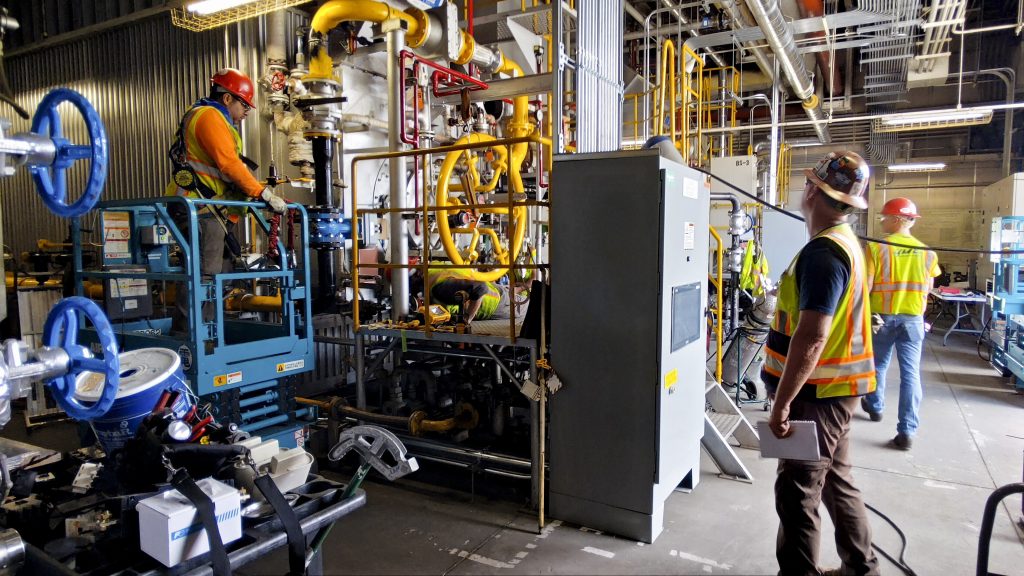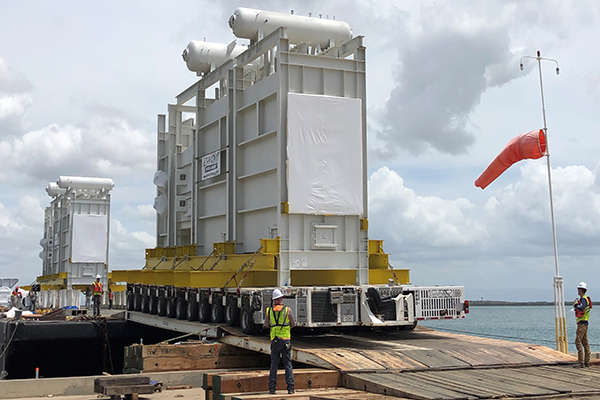By Nancy Balkus, P.E., SES, M.SAME
To increase mission readiness and stay prepared for the energy needs of tomorrow, the Department of the Air Force is investing in microgrid solutions across the enterprise to remain resilient in the face of environmental, physical, and cyber threats.

We must ensure that our installations are postured to project combat power in air, space, and cyberspace. This ready-state is an unquestionable requirement for the Department of the Air Force.
Reliable access to sufficient, quality power makes certain we are prepared to react and recover from any threat, at any time. More than ever, a new era of Great Power Competition and a changing climate demand investment in energy solutions that bolster installation resilience. The Department of the Air Force is pursuing an array of new microgrid technologies to do just that: increase mission readiness and response in the event of a prolonged loss of electrical service.
Unlike centralized power grids that rely on a large network of energy systems, microgrids serve a much smaller footprint and allow power to be distributed directly from onsite generation through a standalone system. This enables certain electrical loads (or an entire installation) to disconnect, or island, from the utility grid with minimal or no impact to operations. Microgrids provide a more sophisticated power system than traditional backup generators because they often are equipped with battery storage systems and advanced controllers that allow installations to retain energy and direct power as necessary for uninterrupted, mission-critical operations.
These attributes make microgrids a more resilient option in the face of potential commercial grid failure due to extreme weather or physical and cyberattacks.
“Firsts” In The Pacific
In the current geopolitical environment, fortifying bases in the Pacific is more important than ever. In August 2023, a Category 4 typhoon slammed into Okinawa, Japan. Despite the storm triggering power outages and emergency warnings throughout the region, Kadena AB was able to sustain operations thanks to a newly installed microgrid. This resiliency demonstrated the real and immediate benefits of the technology for military installations.
Kadena AB is located in “Typhoon Alley” and experiences an average of three storms within 115-mi of the installation during each typhoon season. These weather events are highly disruptive to operations. As such, the base is constantly working to minimize loss of infrastructure to maintain mission function.
Flexible Control. Kadena’s system, composed of five generators with a total capacity of 10-MW, represents the first example of a standby microgrid executed through an energy savings performance contract (ESPC). It does not provide prime power and has simplified topology with power distribution through the existing substation and circuits prioritized for critical mission support.
The microgrid control system can sense the load on various substation circuits, then balance the load and plant capacity by deploying power to the critical circuits within the overall capacity. Additionally, as load varies during an outage, the microgrid control system can shed or energize specific circuits.
Islanding Capability. Also in 2023, the Department of the Air Force completed an advanced microgrid at Yokota AB in Japan. Developed in partnership with Schneider Electric, Yokota’s new 10.72-MW combined heat and power microgrid will elevate base security by enabling the installation to island from the commercial grid in the event of an emergency.
During normal operations, the microgrid’s controller allows Yokota AB to optimize energy use. This can lower costs, decrease emissions, and reduce dependency on the Japanese local Tama power grid. The 24-year ESPC is expected to save the base $12.3 million a year as well as reduce carbon dioxide emissions by 33,000-MT annually.
In May, Team Yokota intentionally put this new system to the test, transitioning from grid-parallel to island mode, and from being fully off (representing a total base electrical outage) to island mode using only power from cogeneration plant generators. The successful island mode and black-start tests were a first for the Department of the Air Force’s ESPC Program and will pave the way for future microgrid architectures at other installations.
Microgrids provide a more sophisticated power system than traditional backup generators because they often are equipped with battery storage systems and advanced controllers that allow installations to retain energy and direct power as necessary for uninterrupted, mission-critical operations.
Innovative Technologies
Domestically, the Department of the Air Force also is pursuing several new microgrid concepts to improve efficiencies and reduce our carbon footprint.
At Kirtland AFB, N.M., we are developing a first-of-its-kind direct current microgrid through the Air Force Research Laboratory. Traditional microgrids convert direct current (provided by solar, storage, or other generation resources) to alternating current before distribution. Direct current microgrids, conversely, incorporate direct current loads that eliminate the need for conversion. This enhances energy resilience and improves system efficiencies by reducing the reliance on current inverters, which are a common failure point for traditional microgrids. The $4.8 million project at Kirtland follows the successful demonstration of a proof-of-concept direct current microgrid at the installation involving housing and community building loads and progresses a multi-year effort to bring this technology forward. The active demonstration will test the ability to deliver resiliency, reliability, and readiness to an operational load on the installation through photovoltaic generation, energy storage, and dynamic load control.
At Francis E. Warren AFB, Wyo., we are exploring the integration of geothermal generation into a district microgrid, which will provide a use case for future implementation of the integrated technology where viable. The 3.5-MW plant will provide power to a microgrid system, complete with a battery energy storage system and a microgrid control system. The control system will maintain continuous power for all primary facilities, while the battery energy storage system is expected to serve as a secondary power source when primary power is lost. This project will provide highly reliable carbon-free electricity and represents the first major geothermal generation microgrid in the Defense Department.

In Florida, we have spearheaded our first Energy Assurance Lease: a solar energy microgrid pilot at Tyndall AFB. Completed in 2022, the solar microgrid system includes a 175-kW photovoltaic solar array and a 1,575-kWh, four-hour battery energy storage system. Florida Power & Light constructed the microgrid and will continue to own, operate, and maintain the system throughout the 10-year agreement. During normal grid operations, power from the microgrid supports the utility’s regular customers, including Tyndall. During outages, the base has first right-of-refusal to backup power for support of three critical facilities via electrically islanded operations. The new microgrid system also includes a manual switch gear control to hook up to a generator in the event of catastrophic failure to ensure mission continuity. This leasing model can be replicated at other bases with other utilities to bolster resilience while reducing overall costs.
In the Northeast, Joint Base McGuire-Dix-Lakehurst, N.J., is executing a $140 million ESPC that includes 31-MW of solar photovoltaics, 4-MW of natural gas generation, a 2-MW/4-MWh battery energy storage system, and a microgrid control system. This design will ensure uninterrupted power supply in support of the base’s critical missions and prepare for future electrical loads from its fleet electrification pilot program. This ESPC is the first Air Force project to capture solar renewable energy credit incentives—providing $34.2 million over the 22-year contract term. Solar renewable energy credits enable greater financial viability of third-party financed projects and enhance operational performance. The servicing utility retains all operations, maintenance, and repair of the energy systems.
Our Path Forward
These bases represent just a small handful of microgrid investments currently underway. Across the enterprise we have more than two dozen microgrid projects in various stages of planning and construction.
Microgrids are an ideal option for many locations, but not everywhere. We are exploring this technology at installations that have critical and essential assets. Ideally suited places for microgrids are able to support large electrical loads and have land and resources available for implementing systems and circuits to centralize generation in a microgrid configuration. Additionally, lifecycle sustainment costs need to be economically feasible.
Each microgrid should be designed to incorporate the unique environment, geography, climate, and other attributes of an installation. Designs and exploration of new technologies are determined by factors such as current electrical configuration, available natural resources and existing fuels, and an ability to harness renewable technologies to extend fuel supplies and support climate goals.
Our airmen and guardians have been disrupting the status quo and driving change for over 75 years. Through this deliberate and repeatable process, the Department of the Air Force is able to provide an agile, reliable, and climate-informed energy resilience solution to our installations amid an increasingly challenging matrix of threats.
We are excited about the future of this technology and remain committed to continuing to push the bounds of innovation.
Nancy Balkus, P.E., SES, M.SAME, is Deputy Assistant Secretary of the Air Force (Environment, Safety & Infrastructure); nancy.balkus@us.af.mil.
More News from TME
-

A Roadmap for Clean Energy on Kwajalein Atoll
A recent effort led by U.S. Army Space & Missile Defense Command to meet the Army Climate Strategy for operations on Kwajalein Atoll studied potential courses of action that would help the remote installation reach 100 percent carbon-pollution free electricity by 2030. -

Pioneering Sustainability in the Federal Sector
As America undergoes a transformative shift to renewable and sustainable power systems, continuing to meet the energy needs of mission-critical installations requires a comprehensive approach that considers economic and cyber factors along with emerging technologies. -

Achieving Energy Self-Sufficiency at Guantanamo Bay
Naval Station Guantanamo Bay achieved energy self-sufficiency through a record-setting energy savings performance contract that enabled construction of a state-of-the-art combined cycle power plant.